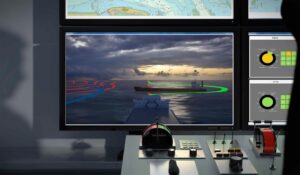Unmanned control rooms for unmanned ships – a new Norwegian research project is not only looking into technical requirements for designing an environment for remotely operated and autonomous ships but also takes into account the Human Factor.[ds_preview]
The goal of research for autonomous or remotely operated ships (Maritime Autonomous Surface Ships, MASS) with a varying degree of manning might be unmanned navigation with promises of cost and environmental efficiency and increased safety. At the Norwegian University of Science and Technology (NTNU) in Trondheim, a new eight-year long centre for research driven innovation named »SFI AutoShip« started in 2021 with the aim of supporting the industry’s attempts to realize autonomous shipping. It might seem counterintuitive to talk about unmanned ships and Human Factors, but as the unmanned ships, autonomous or not, are thought to be remotely supervised, the system will involve humans, so Human Factors (HF) and the Remote Operation Centre (ROC) will be the focus of one of the centre’s work packages.
Challenge: human shortcomings
In the ROC one or several operators will monitor one or several MASS. Human shortcomings will pose challenges for the design of these ROCs. The problems are related to automation complexity and automation surprise, human out-of-the-loop syndrome, Black Swans (the unexpected events) and human-automation teaming. In case of total loss of communication, the MASS need to cope without human supervision. In the meantime, the operator must be kept in the loop by a digital twin sustaining a simulated reality.
For the operator in the ROC there are two pitfalls: underload and overload. For a well-functioning, mature autonomous system, the former will probably be the greater risk: boredom. Week after week monitoring well-functioning ships. Ship Traffic Management (STM) system will in the future take care of separation between vessels and make the monitoring task even more boring.

On the other hand, when something does go wrong and the alarm bells go off, the risk is that we will have a situation of information overload as the operator calls for information needed to get into the loop. It will be a controversy between engineers and Human Factors people: How fast should an operator be able to take over in case of an emergency? Six seconds or six minutes? Engineers want this hand-over period to be short, so that engineering problems can be solved by the human operator. The Human Factor people talk about time-to-get-into-the-loop, operators being distracted, or fatigued, not being able to keep vigilant for long periods.
The argument could be carried even further: maybe we cannot rely on that there will be any operator available at all. »All our operators are presently occupied, please hold the line« might be the answer when a MASS calls for help. Or maybe more likely, there is a communication glitch just when the MASS needs help. In such situations the autonomous navigation system must always have a fallback solution, it must always know what to do if the human operator is not there. Because »stop and hoover«, or »drop anchor«, might not always be the right thing to do when connection is lost. What this means is that a MASS must always be prepared to be »fully autonomous« in the extreme sense of the word. For all practical purposes, we must always assume that the ROC could be unmanned.
Communication glitches between ROC and MASS are very probable scenarios. For the MASS automation it means its »intelligence« must be able to cope with all situations. What does it mean for the remote operator in the ROC? Do all screens turn black? The communication outage will have led to a situation where the ship must make decision by itself, but when the communication system is up and running again after one or many minutes the operator could be completely out of the loop. Therefore, a suggestion is to keep a copy of the onboard automation/AI system in the ROC.
A digital twin of the system
The copy (or digital twin) will, under normal circumstances, be connected to the onboard system so that they are always compatible. Should connection fail, the ROC system will keep feeding the operator with information about what the onbord system will do when it now has lost communication with shore.
Sensor feed (camera, radar, AIS etc.) will of course be lost, but some information, e.g. AIS, might be recieved from land-based infrastructure and the camera view could be instantly replaced by an egocentric VR view constructed from a digital topographical model and ship models positioned by AIS data from land-based sources.
Such a »simulated reality« will start to drift off from what really happens after a while, and control commands based on this simulated reality will not pass through to the MASS, but land-based infrastructure (e.g. land-based radar, see IMAT project) might give some input regarding the own ship’s actions. For some time the operator could be kept in the loop by such a digital twin’s simulation, ready for when the communication is back again.
Author:
Thomas Porathe
NTNU
Excerpts from a paper presented at the Compit 2021 conference
















